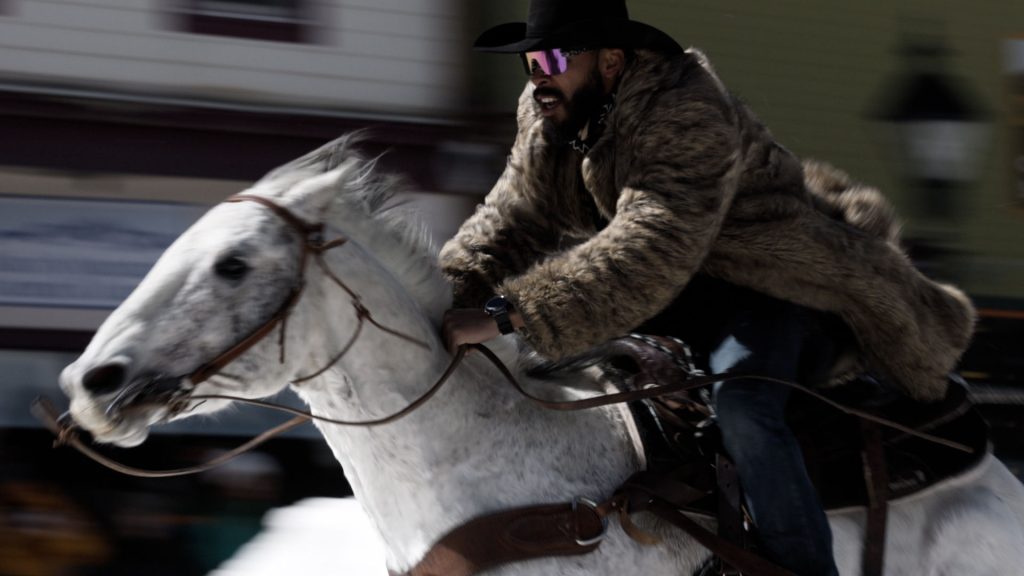
You click into your skis and tighten the buckles on your boots as snug as you can get them.
But you’re not at the top of a mountain. A track, lined with eager spectators, stretches out in front of you complete with gates, jumps and hanging hand rings.
As a horse is led into the start area, you clutch a baton in your right hand that will be used to snag the rings. The horse looks over at you with its big eyes, nostrils flaring as you’re tossed a rope that’s attached to the horse’s saddle.
“The starter’s yelling, ‘Skier, slack! Slack! Bring up the slack!’ Because otherwise, if that horse takes off, you got a bunch of slack, it’ll yank your arm out,” says Duffy Counsell.
This is skijoring, a competitive sport in which a horse and its rider barrel through a 900-foot course at speeds near 40 mph with a skier in tow. Counsell has been involved in the sport for the past 15 years.
“That’s what’s the most nerve wracking — waiting for your turn,” he says.
Then, the horse rips down the track at full speed. In just 15-20 seconds, your turn is over. A dropped baton or missed ring is a two-second penalty. Miss a gate or a jump, and that’s a five-second addition to your time.
“There’s [runs where] I’ve been behind the horse that I’m hanging on for dear life just hoping I can stay alive,” Counsell says. “And then there’s runs where like, ‘Hey, I just hit the sweet spot, I’m cruising at the same speed as the horse now and I can ski anything I want. This is awesome.’ But it doesn’t happen that way often.”
Counsell is also the event organizer for Leadville Ski Joring, which he estimates draws upwards 10,000 people to Cloud City over the course of the weekend.
Leadville is the birthplace of the obstacle course-style skijoring we know today, but now the competition is just one of more than three dozen events that will overtake mountain towns across the Mountain West from Ridgway, Colorado, to Big Sky, Montana, this winter — and some skijor enthusiasts hope the sport will grace the Olympic stage in the next the decade.
Competitors and spectators alike dress the part, wearing everything from wooly chaps, coyote coats and fringe jackets to ’80s ski gear and super hero costumes in a meeting of western ranching culture and hippie ski bums that’s hard to find anywhere else. Events are as big of a party as they are a competition, with competitors overtaking local bars at night and spectators tailgating throughout the day.
“These two cultures coming together is just — how can it not be fun?” says Loren Zhimanskova, chairman of the board of Skijor USA.
Roots
Though Leadville’s event kicked off in 1949, the sport’s roots date back much farther and span across the globe.
Skijoring literally means “ski driving.” While it’s hard to say exactly when it began, petroglyphs in Asia show evidence of people being pulled on skis behind animals thousands of years ago — as long as people have been strapping planks to their feet — according Zhimanskova, who’s basically a human encyclopedia of all things skijor.
“People in mountainous areas with snow needed to traverse expanses, and instead of doing it under their own energy, they harnessed animals or figured out how to have the animals pull them,” she says.
Skijoring is most closely associated with the reindeer-herding Sami people who are indigenous to Scandinavia and still hold races during their winter carnival, Zhimanskova says.
The first record of skijoring using horses was in Norway around 1903 before soon branching into Switzerland, France and the Eastern U.S. The traditional method didn’t involve a rider on the horse — just a skier reigning the animal from behind.
In 1928, skijoring made its first and only appearance at the Winter Olympics in St. Moritz, Switzerland, as a demonstration sport. As it gained popularity, it moved toward the Rockies and took on a more Western style with a rider on the horse and a skier in tow.

Mugs Ossman, who brought obstacle course-style skijoring to Leadville, skis in the town’s event. Credit: Paul Copper
That’s where Leadville’s Mugs Ossman and Tom Schroeder first encountered the sport. The two men were looking for something to bring excitement to the town’s Crystal Carnival and decided to make a trip to Steamboat for inspiration. Horses pulled skiers down the main drag of the town — only Ossman and Schroeder thought the horses were going too slow.
“Mugs had the fastest quarter horses in Lake County, and Tommy Schroeder, the feisty Irishman he was, knew that there wasn’t a horse that could lose him on skis,” Counsell says.
And so, Western-style obstacle course skijoring was born. Leadville Ski Joring hasn’t missed a year since it started and will be in its 76th iteration this winter.
Since 1949, there’s been a proliferation of events — and no two competitions are the same. Some of the courses are U or J shaped, unlike the straightaway of Leadville. Some feature a match-draw format, where you race once in the rider-skier pair you came with and once in a random pairing.
Switcheroo events — where the rider and skier switch places — have also gained popularity.
“You’d be surprised how many people are really good at both,” Zhimanskova says. “Also, it’s kind of funny to see the ones who signed up Friday night when they’re really drunk and they go, ‘I can’t believe I agreed to do this.’”
In the last eight years or so, snowboarders have gotten involved too, which led to the addition of rollers and bank turns at some courses as well as freestyle events, Zhimanskova says.
She hopes to see the sport grow in the coming years and is working to get skijor into the Salt Lake City Winter Olympics as part of a ceremony or demonstration, likely in 2030 or 2034.
‘Got the guts?’
Many of the competitors who brave the world of skijor have racing or extreme skiing experience. Others are just “solid skiers,” Counsell says. But the skill isn’t what Counsell, who skis 100 days a year, says is most important: “It’s more the courage: Do you got the guts to go out and try something?”
Guts are necessary in a sport that can leave competitors with everything from broken ribs and fingers to glove-ripping rope burn to career-ending knee injuries. “You have to be prepared for everything from hero to tragedy if you’re gonna get involved in something like skijoring,” Counsell says.
That risk doesn’t come without reward — skijor victories mean cash prizes up to thousands of dollars. Plus, the crowd loves it.
“It’s some of the closest to, like, celebrity status that I’ll probably ever get,” Counsell says, who’s won competitions, though never Leadville. “It’s so neat when you go into these typically small mountain towns and you’re the guy out there putting your neck and nuts on the line.”
It’s a straight shot of adrenaline, and while there’s riders and skiers alike who are well-known on the skijor circuit, new adrenaline junkies are catching the skijor bug every year.
Josh King, a Telluride-based photographer and videographer who started shooting skijor events last year, competed for his first time last year in Pagosa Springs.

Rider Mike Miller in Big Sky, Montana. Credit: Josh King
“You can’t practice, which is crazy. So you kind of just show up, have to be a little bit psychotic,” he says. “Someone puts a rope in your hands, and you’re like, ‘Hey, any advice?’ And everyone’s only advice is: ‘Don’t drop the rope.’”
His first run was clean — after that, he was hooked. He competed again in Big Sky and Leadville, where he finished second being pulled by rider Noah Gregory. He also competed in a switcheroo and plans to compete at Ridgway, Silverton, Pinedale, Wyoming, Leadville and maybe Big Sky and Whitefish, Montana.
Bella Manzo, a 25-year-old rider from Boulder, competed for her first time last year in Leadville. Manzo, who doesn’t ski or snowboard but has ridden horses for more than 15 years, says she was looking for a winter sport to get involved in when she found skijor.
“You’ve got the crowd on both sides. They’re so excited. You can kind of feel your skier in the back going over jumps trying to click rings, and it was like a blink of an eye,” she says. “Going as fast as you are and just trying to make sure your horse keeps their balance in the snow and making sure that everything is happening safely was my focus, and then trying to make sure you can stop at the end — because the horses really do love it, and they want to keep running.”
‘Three heartbeats’
Much of the rider’s work happens before the race even begins, Manzo says. She rode a friend’s horse last year and is working to desensitize her horse, Kida, for this year’s season.
King says it’s typical for riders and skiers to walk the course together before a race.
“You’re like, ‘Hey, it would help if you could get your horse over to the left side of the course here, slow the horse down here and speed up here’ — this whole communication before the race goes down,” King says. “The best riders really know how to do that for you, and then other riders are just like, ‘Fuck it. We’re just gonna go as fast as we can the whole time, and good luck.’”

Rider Bella Manzo competes at Leadville Ski Joring. Credit: Madison Eckstein
At the end of the day, success requires the skier and the rider to work in tandem.
“It’s three heartbeats that need to work as one,” Counsell says. “If you’re on different pages, it ain’t never going to work out.”
Despite the fierce competition, ego and gatekeeping are noticeably absent from the sport, King says. Counsell echoes that sentiment.
“The story behind the story I always tell everybody is family,” Counsell says of the bond between skiers, riders, volunteers and event organizers.
Counsell, who first got into the sport through his kids when they competed in Leadville’s kids’ snowmobile division over a decade ago, had a knee replacement last year and isn’t sure he’ll compete again in the upcoming season. Still, he’ll be cheering on his son and plans to travel to events to help out. Paul Copper, who was instrumental in making Leadville Ski Joring what it is today and is almost 70, still works registration. Jody Manly, known as the godfather of skijoring, was out on the track working a shovel the year before he passed away, Counsell says.
“When you engage in putting your goodwill, your health on the line — when you do that together with people, that creates an unbreakable bond,” he says. “We are definitely competitors out there trying to beat each other and take each other’s money, but at the same time, we want each other’s best and everybody helps everybody.”














